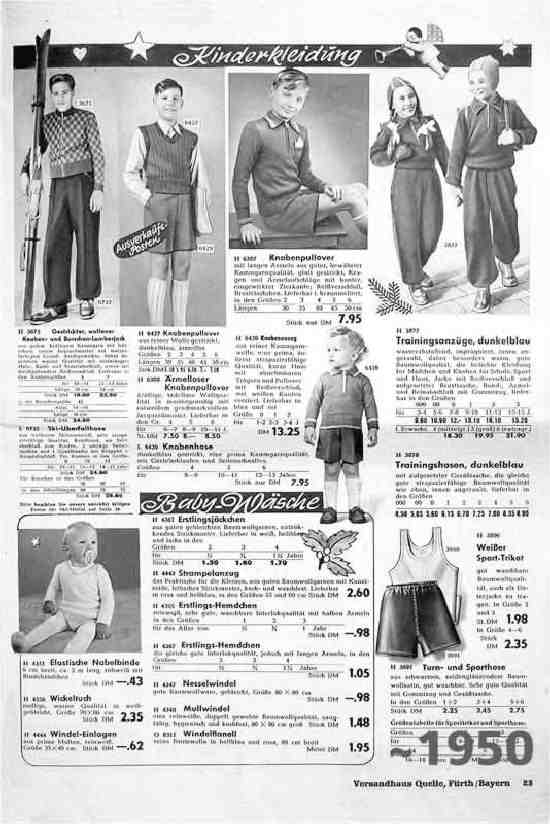
German Catalogs with Boys Clothings (Quelle, 1950)

Figure 1.--The page from a 1950 Quelle catalog is labeled "Kinderkleidung" meaning childrem's garments. It looks to be seasonal cold weather clothes for children, mostly boys. The modeled are full height figures, displaying some items not actually offerred for sale.
|
|
The Quelle catalog had a page with sweaters, and snow suits along with other items such as kneesocks. A skiing style sweater was shown worn with ankle-length knickers. Another garment looks something like a sweater, but appears to be a long-sleeve knit shirt. The sweaters are shown as worn with short pants. The snowsuits for boys and girls look identical. We are not sure what German company put out the catalog.
I wan't sure what catalog this was from. A HBC reader tells us that the catalog page is from Quelle . It is a very popular mail order company based in Fuerth, Bavaria (where Henry Kissinger was
born). The company operates in France. A French reader reports, "The articles selling in Germany are practically the same found in France. One of the older manufactrers was located in Orléan ( France ). This firm still exsit and is quite important.
Kinderkleidung
The page is labeled "Kinderkleidung" meaning childrem's garments.
Kleid meand "dress" and kleiden "to dress"--the sameusage as in English. Bekleidung means clothing or clothes. Kinderkleidung means children's clothes. (There is no umlaut on the u. The dash on top of the u simply means that the word should be pronounced without the umlaut: oo. It is common in German to use that little line because the Germans often do not differentiate between the letters n and u in writing, they look the same, that's why they put that dash on the u. It's not an umlaut.) The page looks to be seasonal cold weather clothes for children, mostly boys. The modeld are full height figures, displaying some items not actually offerred for sale.
Caps
The only caps shown are worn by the children in snow suits. The snow suits look identical, but the caps are somewhat different. The boy kooks to be wearing a stocking cap. The girl looks to be wearing some kind of hat fiting closely on her head. I have seen German children wearing this style of cap in other images.
Ski Outfit
The boy at left wears a skiing style sweater with ankle-length knickers.
Sweater
The next boy wears a sleevless "v" neck sweater. It appars to be call a "knabenpullover", meaning a boy's pullover. He is shown wearing short pants which are called "knabenhose" or boys' pants. The sizes are shown as 4-6. I'm not sure just what these numbers meant, but the catalog indicates the following: size 4 (age 4-7), size 5 (6?-9?), and 6 (unreadable).
Knit shirt
Another garment looks something like a sweater, but appears to be a long-sleeve knit shirt. Like the sweater is is called a "knbenpullover", meaning of course a boy's pullover. The boy wearing the knit shirt is also shown as wearing short pants and kneesocks.
Snowsuits
The snowsuits for boys and girls look identical. The snowsuits are called "Traliningsanzüge, dunkelblau". The word does not mean snowsuit, but rather "Trainingsanzug" means exercise outfit from the English word "training". "Dunkelblau means dark blue. The two snow suits or exercise outfits look identical in the illustrations, but thee are to lisings so there must be some difference. The are worn with ankle-length knicker.
HBC

Navigate the Boys' Historical Clothing catalog/magazine pages:
[Return to the Main German 1950 catalog page]
[Main photo/publishing page]
[Store catalogs]
[Fashion magazines]
Navigate the Boys' Historical Clothing Web Site:
[Introduction]
[Activities]
[Biographies]
[Chronology]
[Clothing styles]
[Countries]
[Topics]
[Bibliographies]
[Contributions]
[FAQs]
[Glossaries]
[Satellite sites]
[Tools]
[Boys' Clothing Home]
Navigate the Boys' Historical Clothing Web Site:
[Sailor suits]
[Sailor hats]
[Buster Brown suits]
[Eton suits]
[Rompers]
[Tunics]
[Smocks]
[Pinafores]
Created: October 21, 2002
Last updated: October 24, 2002



